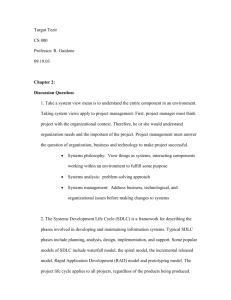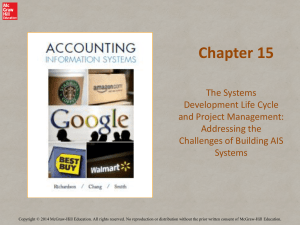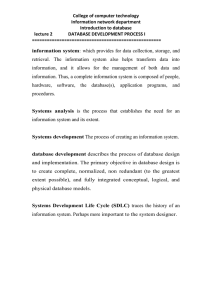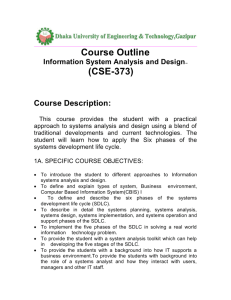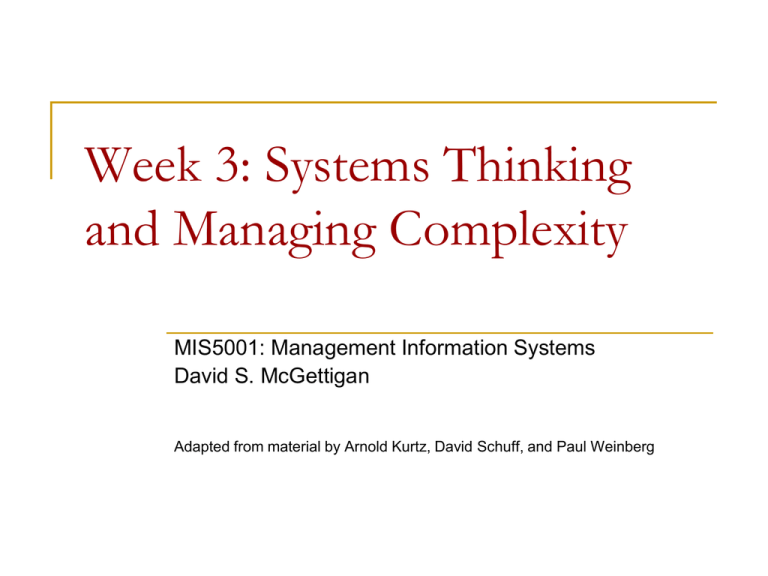
Week 3: Systems Thinking
and Managing Complexity
MIS5001: Management Information Systems
David S. McGettigan
Adapted from material by Arnold Kurtz, David Schuff, and Paul Weinberg
Agenda
Prior Lecture Recap
Managing Complexity:
Person: Role of the CIO
Methodology: System Development Lifecycle
Tool: Business Process Mapping (covered in last
week’s lecture and in this week’s reading)
Case study: STARS Air Ambulance: An
Information Systems Challenge
Next Week
2
Prior Lecture Recap
Decision making
Types of Systems
Structured vs. Non-structured decision
Recurring vs. Nonrecurring
Transaction Processing Systems
Management Information Systems
Decision Support Systems
Business Process Management
Definition
Benefits
Linkage to IS
3
Role of the CIO
Effective leadership is not about making
speeches or being liked; leadership is defined
by results not attributes.
Peter Drucker
CIO Responsibilities
Strategic Planning – Aligning the direction of IS with
that of the business
Operations – running the corporate information
center
Project Management – responsibility for large scale
and high cost technical initiatives
Discussion: what are the ideal characteristics of the
CIO? Why can an effective CIO be difficult to find?
Source: Gray, Paul: Manager’s Guide to Making Decisions about Information Systems
5
IT Governance
Steering Committees – objectives are to link IT with
Corporate strategy, establish priorities, allocate
resources, and facilitate communication.
IT Steering Committee – provides guidance across the company
or divisions.
Program Steering Committee – provides guidance within a
particular initiative.
Discussion: What IT committees are likely to be in place
within a firm? How can a firm avoid all IT decisions
going to committee while ensuring appropriate business
buy-in?
Case Study: What governance was in place at STARS
Air Ambulance?
Source: Gray, Paul: Manager’s Guide to Making Decisions about Information Systems
6
State of the CIO
Most Time Spent
Collaborating with CXOs
Making Strategic Decisions
Working on Strategic Business Planning
Obstacles to Success
Overwhelming Project Backlog and Requests
Ability to Execute Remains a Top Concern
Focus on Cost Cutting
Opportunities
Using IT to Enable / Standardize Business Processes
Measuring Success and Proving Business Value
A Modern CIO
Deputies Run Operations
Focus on Strategy and Execution
Source: www.cio.com: “State of the CIO”
7
System Development
Lifecycle
Good plans shape good decisions. That's why
good planning helps to make elusive dreams come
true.
Lester R. Bittel, The Nine Master Keys of Management
Introduction
Systems development life cycle
(SDLC) - a structured step-by-step
approach for developing information
systems.
Copyright 2004
The McGraw-Hill Companies, Inc.
All rights reserved
Management Information Systems
for the Information Age
(Fourth Edition)
9
Seven Phases in the SDLC
Phase 1: Plan
Planning phase - involves determining a
solid plan for developing your information
system.
Critical success factor (CSF) - a factor
simply critical to your organization’s success.
Copyright 2004
The McGraw-Hill Companies, Inc.
All rights reserved
Management Information Systems
for the Information Age
(Fourth Edition)
10
Seven Phases in the SDLC
Phase 1: Plan
Project scope – high-level system requirements.
Project scope document – written project scope definition.
Project plan – defines the what, when, and who questions.
Project milestones - key dates for deliverables.
Project manager - an expert in project planning.
Copyright 2004
The McGraw-Hill Companies, Inc.
All rights reserved
Management Information Systems
for the Information Age
(Fourth Edition)
11
Seven Phases in the SDLC
Phase 2: Analysis
Analysis phase - involves end users and IT
specialists working together to gather, understand,
and document the business requirements for the
proposed system.
Business requirements - the detailed set of
knowledge worker requests that the system must
meet in order to be successful.
Copyright 2004
The McGraw-Hill Companies, Inc.
All rights reserved
Management Information Systems
for the Information Age
(Fourth Edition)
12
Seven Phases in the SDLC
Phase 2: Analysis
Joint application development (JAD) - knowledge
workers and IT specialists meet, sometimes for
several days, to define or review the business
requirements for the system.
Requirements definition document – prioritizes
the business requirements and places them in a
formal comprehensive document.
Sign-off - the knowledge workers’ actual signatures
indicating they approve all of the business
requirements.
Copyright 2004
The McGraw-Hill Companies, Inc.
All rights reserved
Management Information Systems
for the Information Age
(Fourth Edition)
13
Seven Phases in the SDLC
Phase 3: Design
Design phase - build a technical blueprint of
how the proposed system will work.
Technical architecture - defines the hardware,
software, and telecommunications equipment
required to run the system.
Copyright 2004
The McGraw-Hill Companies, Inc.
All rights reserved
Management Information Systems
for the Information Age
(Fourth Edition)
14
Seven Phases in the SDLC
Phase 3: Design
Modeling - the activity of drawing a graphical
representation of a design.
Graphical user interface (GUI) - the interface to an
information system.
GUI screen design - the ability to model the
information system screens for an entire system.
Copyright 2004
The McGraw-Hill Companies, Inc.
All rights reserved
Management Information Systems
for the Information Age
(Fourth Edition)
15
Seven Phases in the SDLC
Phase 3: Design
Copyright 2004
The McGraw-Hill Companies, Inc.
All rights reserved
Management Information Systems
for the Information Age
(Fourth Edition)
16
Seven Phases in the SDLC
Phase 4: Development
Development phase - take all of your
detailed design documents from the design
phase and transform them into an actual
system.
Copyright 2004
The McGraw-Hill Companies, Inc.
All rights reserved
Management Information Systems
for the Information Age
(Fourth Edition)
17
Seven Phases in the SDLC
Phase 5: Test
Testing phase - verifies that the system
works and meets all of the business
requirements defined in the analysis phase.
Test conditions - the detailed steps the
system must perform along with the expected
results of each step.
Copyright 2004
The McGraw-Hill Companies, Inc.
All rights reserved
Management Information Systems
for the Information Age
(Fourth Edition)
18
Pharma Computer Systems Testing /Qualification
TESTING
Development Testing
Validation Testing
KEY:
H/W; S/W; O/S; Envir.
Qualification
End to End Testing; Boundary
Testing; Error Handling
Informal – No QA
signatures needed;
full documentation
required
Integration
Testing
Customization/Integration
Testing
Controlled – No
QA signatures
required; full
documentation
required; must
track problems
Customization Testing
Formal – Under
Change Control;
QA signatures
required; full
documentation
required
Unit
Testing
Infrastructure Qualification
Application
System Application Application Application
Site
Testing
IQ
OQ
PQ
PQ
Testing
Testing
Testing
Testing
Formal - Protocol,
scripts, SOP’s
training
Connectivity, possibly
mini-workflow
Subset
Subset of
Formal - Protocol, scripts,
Of OQ
System
PQ SOP’s, training
Testing;
Formal - Protocol, scripts,
Test Critical
Functionality
PQ SOP’s, training
Formal - Protocol, scripts,
OQ SOP’s, training
Formal - Protocol, scripts, IQ SOP’s, training
Controlled - Protocol, scripts, System Test SOP’s, training
Informal - Protocol, scripts, Integration Testing SOP’s, training
Informal - Protocol, scripts, static verification, Unit Test SOP’s, training
Traceability to URS and FRS across all testing
Validation Plan
Technical Documentation
Stress/Load Testing
DR Scheme & Exercise
Matrices
Val Plan Doc(s)
Sizing; Config; etc.
Protocol; Scripts; SOP’s
Plan; Scripts;
Summaries
Seven Phases in the SDLC
Phase 6: Implement
Implementation phase - distribute the system to all
of the knowledge workers for use.
User documentation - how to use the system.
Online training - runs over the Internet or off a CDROM.
Workshop training - is held in a classroom
environment and lead by an instructor.
Copyright 2004
The McGraw-Hill Companies, Inc.
All rights reserved
Management Information Systems
for the Information Age
(Fourth Edition)
20
Seven Phases in the SDLC
Phase 6: Implement
Change Management – the “change
curve”
Shock
Denial
Hostility
Negotiation
Depression
Trial
Acceptance
21
Seven Phases in the SDLC
Phase 7: Maintain
Maintenance phase - monitor and support
the new system to ensure it continues to
meet the business goals.
Help desk - a group of people who responds
to knowledge workers’ questions.
Copyright 2004
The McGraw-Hill Companies, Inc.
All rights reserved
Management Information Systems
for the Information Age
(Fourth Edition)
22
Why System Projects Fail
20% of systems are successful, 80% of systems
fail.
Five primary reasons why systems fail include:
Unclear or missing requirements
Skipping SDLC phases
Failure to manage project scope
Scope creep – project scope increases
Feature creep – developers add extra features
Failure to manage project plan
Changing technology
Relate to Case Study: were projects at Stars Air
Ambulance “failing”? Why or why not?
Copyright 2004
The McGraw-Hill Companies, Inc.
All rights reserved
Management Information Systems
for the Information Age
(Fourth Edition)
23
Preventing Failure:
Prototyping
Advantages:
Encourages participation.
Resolves discrepancies
Gives a feel for the final system.
Helps determine technical feasibility.
Helps sell the idea of a proposed system.
Disadvantages:
Leads to the belief that the final system will follow shortly.
Gives no performance indication.
Leads the team to skip testing and documentation.
Copyright 2004
The McGraw-Hill Companies, Inc.
All rights reserved
Management Information Systems
for the Information Age
(Fourth Edition)
24
Preventing Failure:
Outsourcing Experience
Advantages:
Focus on unique core competencies.
Exploit the intellect of another organization.
Better predict future costs.
Acquire leading-edge technology.
Reduce costs.
Improve performance accountability.
Disadvantages:
Reduces technical know-how for future innovation.
Reduces degree of control.
Increases vulnerability of strategic information.
Increases dependency on other organizations.
Copyright 2004
The McGraw-Hill Companies, Inc.
All rights reserved
Management Information Systems
for the Information Age
(Fourth Edition)
25
The Role of Knowledge Workers
Participation in the systems development process is
vitally important because they are …
Business process expert
Liaison to the customer
Quality control analyst
Manager of other people
User acceptance testing (UAT) – determines if the
system satisfies the business requirements.
Copyright 2004
The McGraw-Hill Companies, Inc.
All rights reserved
Management Information Systems
for the Information Age
(Fourth Edition)
26
Case Study: STARS Air Ambulance
Discussion Questions:
Identify three or four of the most critical challenges
facing the new CIO and make recommendations for
how Khan can tackle each of these challenges.
What should Kahn’s objectives be for his upcoming
meeting with the CEO and how can he prepare to best
meet them?
What should Kahn do about departments contacting
their “favorite IS staff member” when they need
technical assistance?
How can he change this practice and still gain the trust and
support of the CEO and other senior managers?
27
Next Week
Disruptive Technology and
Organization Innovation

